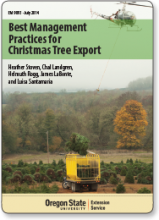Regulations for Mexico
Current regulations for Mexico call for tree shaking for 15 seconds. A number of details can improve (or reduce) the effectiveness of shaking.
- Prune tree bases to sufficient height to fit in the receiving cone on the shaker. Otherwise, if the stiff lower branches sit on top of the cone, they act as shock absorbers and reduce the shaking efficiency.
- Clean out the receiving cone on the shaker frequently. The cone can quickly fill with needles. If the needles are allowed to build up, they act as a shock absorber and minimize the effect of shaking. Some receiving cones have openings on the sides to allow debris to shake out automatically; this can be an effective feature.
Debris piles
Besides containing dead needles, debris piles contain pests previously shaken off. These pests can migrate to piles of harvested trees and cause recontamination. Move your shaking operation away from the landing area or frequently remove the piles of debris. At the loading site, separate the debris piles and the trees, and remove the debris often.
